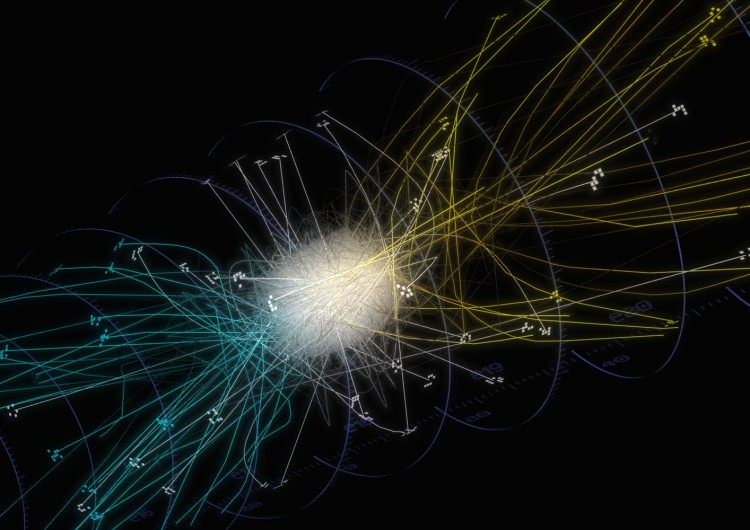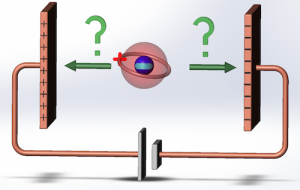
Trajectories of antihydrogen atoms released from the ALPHA trap. The dots represent where the anti-atoms annihilate on the trap wall; under the influence of an electric field, the different charges, which are all very close to zero, segregate to different areas of the trap. Chukman So, Berkeley
Hydrogen is a neutral atom. Its single electron orbits a single proton, and the net effect is no electrical charge. But what about hydrogen’s antimatter counterpart, antihydrogen? Made of a positron that orbits an antiproton, the antihydrogen atom should be neutral too. Various results have indicated as much, but because the charge of antiatoms is difficult to measure, it has remained an open question.
A recent experiment to measure the charge of antihydrogen has now placed a bound on the atom’s charge. Physicists from Berkeley Lab, the University of California, and other institutions part of the ALPHA collaboration at CERN, have published in Nature Communications a new measurement of the charge of antihydrogen, determined with unprecedented precision.
The result: effectively zero. Specifically, antihydrogen’s charge is less than 20 billionths of the magnitude of the electron charge, a measurement that’s a million-fold improvement over the best previous experiment. This is good news for fundamental theories of physics.
“We would expect the charge of hydrogen and antihydrogen to be the same,” says Jonathan Wurtele, physicist at Berkeley Lab and UC and author on the paper. “If we had seen a charge, we would have new physics. ”
Antihydrogen resists easy measurement for a number of reasons, starting with its production. While positrons are relatively straightforward to obtain, low energy antiprotons are only available at the Antiproton Decelerator at CERN. (Antiprotons were first created in 1955 at Berkeley Lab’s now decommissioned Bevatron accelerator.)
Once produced through high-energy collisions, the particles then need to be slowed down and cooled. Next, electrodes manipulate the electric field to mix antiprotons with positrons, making a few atoms of antihydrogen. These atoms are then trapped in a magnetic “bottle.” It takes thousands of positron-antiproton mixings to produce just 500 atoms of trapped antihydrogen.
The experimental measurements only happens when the magnetic field trap is turned off, effectively pouring atoms out of the bottle and into a vacuum chamber. Once free, an atom of antihydrogen will contact an atom of normal matter on the trap wall, and the two annihilate each other. This annihilation leaves a signal, evidence of the antihydrogen’s position.
For the charge-measurement experiment, the scientists took advantage of the fact that there were strong electric fields within the trap. “If the antiatom were charged”, says Joel Fajans, physicist at UC and Berkeley Lab “these fields would push the antiatom to the left side or to the right side of the trap, depending on the putative sign of antihydrogen charge.” Analysis of data showed that there was no tendency for the anti-atoms to go to the left or right, implying that the atom was electrically neutral.

When an anti-atom is put into an electric field, does it feel a force? It will only feel a force if it has a net charge. Normal matter atoms are known to be charge neutral to an extraordinary precision, and modern physics theories assert that anti-atoms would be similarly charge neutral. New Berkeley Lab research confirms that antihydrogen atoms are indeed charge neutral to at least nearly 10ppb of the unit charge. Credit: Joel Fajans, Berkeley
Fajans, Wurtele, and Marcello Baquero-Ruiz and Alex Povilus, both graduate students in the physics department at the University of California, as well as Berkeley post-doc Andre Zhmoginov, Berkeley instructor Andrew Charman, and Berkeley undergraduate Arielle Little, did much of the simulation work and modeling of the system as well as developing statistical techniques for data analysis. The data itself was collected by the entire ALPHA collaboration.
Other recent work by the Berkeley group and Francis Robicheaux at Purdue indicates that future experimental bounds could reach approximately 100 times higher precision using a technique based on an approach called stochastic acceleration.
Previously, Fajans and Wurtele were involved in ALPHA experiments to measure the microwave spectrum of antihydrogen as well as the effects of gravity on antihydrogen, which, as far as experiments can currently determine, interacts with it the same as it does hydrogen. Next up are measurements of the anti-atoms’ energy levels
A better understanding of the properties of antimatter in general and anti atoms in particular is important to solving the so-called Baryogenesis problem, which essentially questions why the universe has more matter than antimatter.
“People have been trying to explain the baryogenesis problem for years without success. It seems that our current understanding is incomplete,” says Fajans. “There are some possible straightforward explanations out there, but physicists wonder if the baryogenesis problem can only be explained by something more interesting or exotic. Anomalies with antihydrogen could be the answer.”
This research was funded in part by the U.S. Department of Energy and the Laboratory Directed Research and Development program at Berkeley Lab.